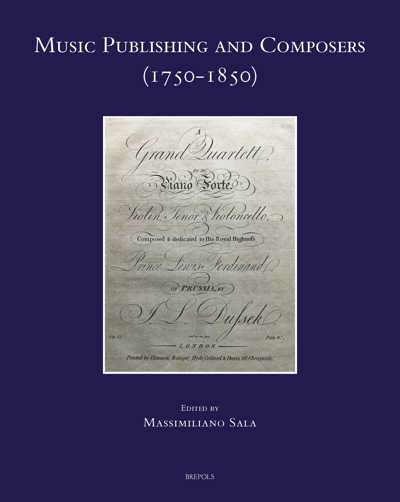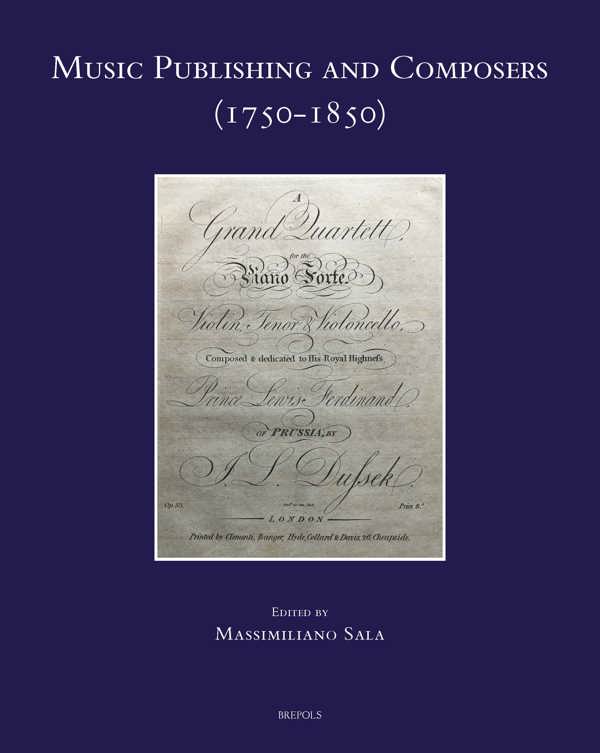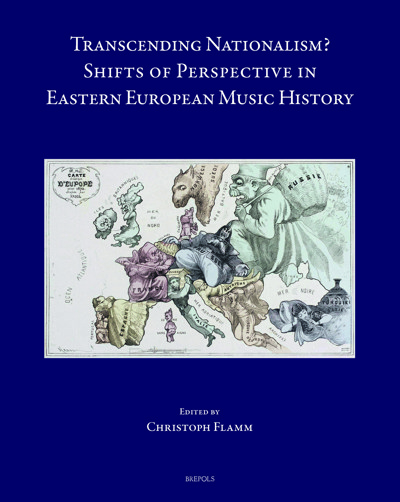
Music Publishing and Composers (1750-1850)
Massimiliano Sala (ed)
- Pages: 336 p.
- Size:210 x 260 mm
- Illustrations:30 b/w
- Language(s):English, Italian, French
- Publication Year:2020
- € 115,00 EXCL. VAT RETAIL PRICE
- ISBN: 978-2-503-58815-5
- Hardback
- Available
The volume focuses on the role of music publishing between 18th and 19th century
"The fifteen chapters in this richly contoured book achieve a high level of productive analysis in exploring the diverse context where major changes occurred in musical culture (...)". (William Weber, in Music & Letters, 13/07/2021, p. 160)
MASSIMILIANO SALA is Vice President of the Centro Studi Opera Omnia Luigi Boccherini (Lucca) and Secretary Treasurer of the Italian National Edition of Pietro Antonio Locatelli’s Complete Works. On the Board of the Scholarly Committees of the Italian National Edition of Muzio Clementi’s Complete Works and Italian National Edition of Luigi Boccherini’s Complete Works, he is a founder of Ad Parnassum Journal. His publications include writings on eighteenth- to twentieth-centuries music.
The development of music publishing in the final years of the eighteenth and first decades of the nineteenth century had a decisive and far-reaching influence on every facet of the music profession. The proliferation of publications substantially altered the conception of the musical work and the nature and extent of intellectual property. Increasingly this allowed composers to support themselves financially through the sale of their own works, or even to establish, or collaborate in, publishing houses. The needs of contemporary consumers of music and new approaches to the production and dissemination of the musical work conditioned, and were conditioned by, the ever-evolving spheres of public and domestic performance that, in turn, stimulated the emergence of new musical forms and genres. This book focuses on the role of music publishing within the daily life and activities of composers at the turn nineteenth century, and its impact on subsequent patterns of development that influenced the course of nineteenth-century music.
Massimiliano Sala, Preface
Composers, Editions and the Musical Work
Nancy November, Beethoven’s Symphonies Arranged for the Chamber by His Contemporaries
Rainer Kleinertz, Werk und Zyklus. Zur Reihenfolge der Streichquartette in Haydns Opus 33 und Mozarts Opus 10
Maria Birbili, The Proliferation of Musical Sources in the 19th Century: An Abridged Editorial History of Rossini, Verdi, and Puccini’s Italian Opera
Myron Gray, What Is an Author of Early American Music? «Die Zauberflöte» and the Culture of Reprinting
The Market, the Rights and Publishing Strategies
David Rowland, Composers, Publishers and the Market in Late Georgian Britain
Bianca Maria Antolini, Compositori, editori, fruitori: una rete di rapporti
Giovanna Carugno, A chi apparteneva il «Nabucco»? Note storiche sulla «proprietà dello spartito» e sulla controversa tra gli editori Lucca e Ricordi
Floris Meens, «Eine heillose Geschichte!»: The Discourse on Publishers in Dutch Music Journals (ca. 1839-1860)
Circulation
Henri Vanhulst, Compositeurs ‘belges’ de musique instrumentale édités à Paris au XVIIIe siècle: la quête reconnaissance internationale
Stephanie Klauk, Handschriftliche Überlieferung von Streichquartetten im Rom des 18. Jahrhunderts
Sarah Noemi Schulmeister, Musikverleger des 18. Jahrhunderts als international agierende Akteure des Transfers: Der Fall Antoine Huberty
Elisabetta Righini, Disavventure editoriali e concertistiche di Giovanni Battista Cirri dal soggiorno londinese (1764-1775) al rientro in patria
Repertoire and Public
Maria João Albuquerque, Music Printing and Publishing in Portugal (1750-1850): The Rise of a New Industry
Francisco J. Giménez-Rodríguez, Four Unknown Waltzes by Beethoven? The Beginnings of Sheet Music Publishing in Spanish Periodicals (1805-1834)
Gloria Araceli Rodríguez Lorenzo, «La Iberia Musical y Literaria» (1842-1846): Connecting the Public and Private Sphere




